Difference between revisions of "Testing Article1"
| Line 1: | Line 1: | ||
| − | == | + | ==Overview== |
| − | + | Every '''chart''' has an annotated '''time axis''' coordinated with the various '''start/finish dates''' of task bars and milestone symbols represented in the '''graph'''. OnePager provides the option of displaying of at least one and up to three '''Time Axis Levels''' under your control. OnePager is distributed with '''Template Properties''' forms that typically show three '''Time Axis Levels ''': '''Years''', '''Quarters''', and '''Months''', for example. | |
| − | + | '''Time Axis Levels''' can be scaled into '''different units of time''' by using the '''editing '''controls provided in the '''Template Properties '''form or the '''Chart Properties ''' form’s '''Time Axis '''tabs shown below. The '''Timespan''' of the '''Time Axis '''in the chart depends on the '''Start '''and '''Finish''' '''dates''' either that you input or that are calculated by OnePager from your '''source plan'''. Once a chart is created, you have the '''editing '''controls available to restructure the number of '''Time Axis Levels''' displayed, their '''units of time''', the '''font properties '''of '''text''' contained in each '''Time Axis cell''', and several other attributes as explained in other articles in this series. | |
| − | + | For access to the full set of '''Time Axis''' articles, click here: [[Modifying the Time Axis for Version 7.0 (Portal) | Modifying the Time Axis (Portal)]] <!--22.0.1-70--> | |
| − | + | ||
| − | + | ||
| − | + | ||
| − | + | ||
| − | + | ||
| − | + | ||
| − | + | ||
| − | + | ||
| − | + | You also have the capability to position the '''Time Axis '''on the '''Top''' or '''Bottom '''of the '''graph''' or in '''both '''locations under your control. | |
| − | + | The '''Floating Time Axis''' feature provides the capability to insert '''Time Axis Levels''' into the body of the '''graph''' at any '''row '''position. | |
| − | + | For more information on the '''Floating Time Axis''', please see the article at: [[The Floating Time Axis Feature for OnePager Pro for Version 7.0 | The Floating Time Axis Feature for OnePager Pro]] <!--22.3.9-70--> | |
| − | + | There are '''editing '''capabilities available using '''Chart Editor ''' '''editing''' techniques and convenient '''editing '''controls added to the OnePager Pro ribbon tool bar. The remainder of this article provides basic examples of how the '''Time Axis '''feature in OnePager can be used to configure appropriate '''Time Axis '''displays. | |
| − | + | ==Using the Chart Properties Form’s Time Axis Tab== | |
| − | + | As previously mentioned, OnePager Pro consolidates all the '''Time Axis '''controls into a new '''Chart Properties '''form tab called the '''Time Axis '''tab. The '''Chart Properties '''form’s '''Time Axis '''tab is almost identical to the same tab on the '''Template Properties''' form so the '''Chart Properties '''form’s '''Time Axis '''tab and its five (5) sub-tabs are used here for the illustrations and examples that follow. In the following sub-sections below are illustrations showing the various sub-tab subsets for the '''Chart Properties''' form’s '''Time Axis '''tab: | |
| − | + | ||
| − | + | ===Calendar Sub-Tab=== | |
| − | + | The '''Calendar Sub-Tab''' looks like this: | |
| − | + | <center>[[File:P70-21_17_1-70-(1)-10242020.png]]</center> | |
| + | <!--<center>P70-21_17_1-70-(1)-10242020.png</center>--> | ||
| − | + | ===Top, Middle, and Bottom Level Sub-Tabs=== | |
| − | + | ||
| − | + | The '''Middle Level Sub-Tab''', which is typical of the three (3) such sub-tabs, looks like this: | |
| − | <center>[[File:P70- | + | <center>[[File:P70-21_17_1-70-(2)-10242020.png]]</center> |
| − | + | <center>P70-21_17_1-70-(2)-10242020.png</center> | |
| − | === | + | ===Format Sub-Tab=== |
| − | ''' | + | The '''Format Sub-Tab''' looks like this: |
| − | + | <center>[[File:P70-21_17_1-70-(3)-10242020.png]]</center> | |
| + | <!--<center>P70-21_17_1-70-(3)-10242020.png</center>--> | ||
| − | + | More information on '''editing''' with the '''Chart Properties '''form’s '''Time Axis '''tab and sub-tabs, please see the article at: [[Editing Time Axes with the Chart Properties Form for OnePager Pro for Version 7.0 | Editing Time Axes with the Chart Properties Form for OnePager Pro]] <!--22.4.1-70--> | |
| − | <!-- | + | |
| − | ''' | + | Given the controls shown above, you have significant control over the display of the '''Time Axis '''as discussed under the topics that follow. |
| − | == | + | ==Globally Editing Chart Time Axis Levels and Cells== |
| − | + | Global '''edits''' are made in the '''Template Properties '''form for all charts created with that '''Template Properties''' form or with the '''Chart Properties''' form for all '''editable''' graphic elements with a particular chart covered by that '''Chart Properties''' form. The examples that follow are made with the '''Chart Properties''' form. Below is a sample chart showing some '''edits''' in the three '''Time Axes''' for '''level height''', '''cell text color''', '''background colors,''' and '''cell height''': | |
| − | <center>[[File:P70- | + | <center>[[File:P70-22_1_1-70-(1)-10262020.png]]</center> |
| − | <!--<center>P70- | + | <!--<center>P70-22_1_1-70-(1)-10262020.png</center>--> |
| − | + | ===Editing the Chart’s Start/Finish Date Boundaries=== | |
| − | + | In previous OnePager versions setting the '''Start/Finish Date boundaries''' for the chart was in the '''Chart Properties''' form’s '''Main''' tab. These controls are now consolidated in the '''Chart Properties '''form’s new '''Time Axis '''tab at the '''Calendar '''sub-tab as shown here: | |
| − | + | ||
| − | + | <center>[[File:P70-22_1_1-70-(2)-10262020.png]]</center> | |
| + | <!--<center>P70-22_1_1-70-(2)-10262020.png</center>--> | ||
| − | (23.2.1-70) | + | The '''Start Date''' and '''Finish Date''' '''boundaries''' can be '''edited''' by accessing the '''Calendar '''dropdown as shown below: |
| + | |||
| + | <center>[[File:P70-22_1_1-70-(3)-10262020.png]]</center> | ||
| + | <!--<center>P70-22_1_1-70-(3)-10262020.png</center>--> | ||
| + | |||
| + | Making '''edits''' to the '''Start Date '''and/or''' Finish Date boundaries''' resets the '''Date Boundaries '''for the chart. | ||
| + | |||
| + | Another way to '''edit''' the chart’s '''Date Boundaries''' is to use the '''Start '''and '''Finish Date''' '''Calendars''' available on the OnePager Pro '''View''' ribbon tool bar tab in the '''Dates''' group as shown here: | ||
| + | |||
| + | <center>[[File:P70-22_1_1-70-(4)-10262020.png]]</center> | ||
| + | <!--<center>P70-22_1_1-70-(4)-10262020.png</center>--> | ||
| + | |||
| + | More information on changing the '''Start/Finish Date boundaries''', please see the article at: [[Changing the Chart’s Start/Finish Dates for OnePager Pro for Version 7.0 | Changing the Chart’s Start/Finish Dates for OnePager Pro]] <!--22.3.1-70--> | ||
| + | |||
| + | ===Showing and Hiding Time Axis Levels and Cells=== | ||
| + | |||
| + | '''Time Axis Level Cells''' and '''Floating Time Axis''' '''Level Cells''' can be '''hidden '''to create '''timespan''' '''gaps''' in the chart's '''timeline'''. | ||
| + | |||
| + | The following example shows the creation of such a '''timespan gap''': | ||
| + | |||
| + | :1) Below is the original '''Time Axis '''with all '''Cells shown''': | ||
| + | |||
| + | <center>[[File:P70-22_1_1-70-(5)-10262020.png]]</center> | ||
| + | <!--<center>P70-22_1_1-70-(5)-10262020.png</center>--> | ||
| + | |||
| + | :2) You can manually '''select''' the months of September through November of 2019 (with a '''CTL+Left-Click''') and '''hide''' the '''cells''' by a right-click on a selected '''Cell''' to access the '''time axis''' right-click '''context menu''' and the '''Hide cell''' command as shown below: | ||
| + | |||
| + | <center>[[File:P70-22_1_1-70-(6)-10262020.png]]</center> | ||
| + | <!--<center>P70-22_1_1-70-(6)-10262020.png</center>--> | ||
| + | |||
| + | :3) Clicking the '''Hide cell '''command results in the chart looking like this: | ||
| + | |||
| + | <center>[[File:P70-22_1_1-70-(7)-10262020.png]]</center> | ||
| + | <!--<center>P70-22_1_1-70-(7)-10262020.png</center>--> | ||
| + | |||
| + | As the illustration above shows, a '''three month timespan''' is '''hidden '''in the '''gap'''. OnePager retains a record of this in the table found in the '''Chart Properties '''form '''Time Axis '''tab '''Format '''sub-tab’s '''Curtains and Timespans '''control group as shown below: | ||
| + | |||
| + | <center>[[File:P70-22_1_1-70-(8)-10262020.png]]</center> | ||
| + | <!--<center>P70-22_1_1-70-(8)-10262020.png</center>--> | ||
| + | |||
| + | If, in the course of '''Hiding Time Axis Level Cells''', task bars/milestone symbols become '''hidden''', entries are made in the '''Where’s My Stuff!? '''form. Select the '''Quarterly Time Axis Level Cells''' to be '''hidden''' as shown below: | ||
| + | |||
| + | <center>[[File:P70-22_1_1-70-(9)-10262020.png]]</center> | ||
| + | <!--<center>P70-22_1_1-70-(9)-10262020.png</center>--> | ||
| + | |||
| + | After '''hiding '''the two '''Quarterly Time Axis Level Cells''' the chart looks like this with the '''Where’s My Stuff!? '''form visible: | ||
| + | |||
| + | <center>[[File:P70-22_1_1-70-(10)-10262020.png]]</center> | ||
| + | <!--<center>P70-22_1_1-70-(10)-10262020.png</center>--> | ||
| + | |||
| + | To '''restore''' the '''Time Axis Level Cells '''select the five entries by checking each checkbox in the '''Select''' column (or clicking the''' Select All''' button) in the '''Where’s My Stuff!?''' form as is shown in the example below: | ||
| + | |||
| + | <center>[[File:P70-22_1_1-70-(11)-10262020.png]]</center> | ||
| + | <!--<center>P70-22_1_1-70-(11)-10262020.png</center>--> | ||
| + | |||
| + | Clicking the '''Fix Selected '''button updates the '''Where’s My Stuff!?''' form to look like this: | ||
| + | |||
| + | <center>[[File:P70-22_1_1-70-(12)-10262020.png]]</center> | ||
| + | <!--<center>P70-22_1_1-70-(12)-10262020.png</center>--> | ||
| + | |||
| + | The action '''restores''' the five selected task bars to visibility along with their associated '''Quarterly Time Axis Level Cells''' as shown below: | ||
| + | |||
| + | <center>[[File:P70-22_1_1-70-(13)-10262020.png]]</center> | ||
| + | <!--<center>P70-22_1_1-70-(13)-10262020.png</center>--> | ||
| + | |||
| + | For more information on the '''Where’s My Stuff!? '''form, please see the article at: [[Managing Hidden Tasks and Milestones Using "Where's My Stuff?!" for Version 7.0 | Managing Hidden Tasks and Milestones Using "Where's My Stuff?!"]] <!--9.4.1-70--> | ||
| + | |||
| + | '''Hidden Time Axis Level Cells''' can be '''restored''' by using the controls on the OnePager '''Home''' ribbon tool bar tab’s '''Show/Hide '''dropdown menu by clicking the '''Show All Time Axis Cells''' command as seen here: | ||
| + | |||
| + | <center>[[File:P70-22_1_1-70-(14)-10262020.png]]</center> | ||
| + | <!--<center>P70-22_1_1-70-(14)-10262020.png</center>--> | ||
| + | |||
| + | After clicking the '''Show All Time Axis Cells''' command, the five '''hidden''' month '''Time Axis Level Cells '''become '''unhidden'''. The dates used in the '''Curtains and Timespans Grid''' to define the '''hidden''' '''timespan''' include not only the date for '''From/To Dates''' but the '''time of day''' as well. If you just specify '''dates''', OnePager assumes that the '''From Date''' starts at midnight on that day and the '''To Date''' end a minute before midnight on that day. To completely specify the '''timespan '''for a '''Time Axis Level Cell''' to be '''hidden''' it is important to make sure that the '''timespan''' is complete. | ||
| + | |||
| + | As an example, to '''hide '''the month of January 2019 the '''From Date '''should be 1/1/2019 and the '''To Date '''should be 2/1/2019 as shown here: '''- Replace with New Screenshot''' | ||
| + | |||
| + | <center>[[File:P70-22_1_1-70-(15)-10262020.png]]</center> | ||
| + | <!--<center>P70-22_1_1-70-(15)-10262020.png</center>--> | ||
| + | |||
| + | '''Hiding Time Axis Level Cells''' overrides all other settings that you specify by way of '''Flagging '''task bars for import or any specified '''Conditional Import rules''' you defined. Although the import takes place, '''hidden''' '''Time Axis Level Cells''' govern what is '''shown''' after import. | ||
| + | |||
| + | More information on '''hiding/showing''' '''Time Axis Cells ''', please see the article at: [[Showing and Hiding Time Axis Levels and Cells for OnePager Pro for Version 7.0 | Showing and Hiding Time Axis Levels and Cells for OnePager Pro]] <!--22.3.3-70--> | ||
| + | |||
| + | ===Re-Ordering Time Axis Levels=== | ||
| + | |||
| + | In addition to being able to now easily '''hide Time Axis Levels''', you can also '''exchange''' '''Time Axis Level''' positions. Given the chart below where the '''Top''', '''Middle''', and '''Bottom Time Axis Levels '''in Year, Quarter, and Month are ordered from top to bottom, you can '''exchange '''the '''Middle Level''' with the '''Top Level''' by clicking the '''up arrow '''in the '''Re-Order Levels''' control group: | ||
| + | |||
| + | <center>[[File:P70-22_1_1-70-(16)-10262020.png]]</center> | ||
| + | <!--<center>P70-22_1_1-70-(16)-10262020.png</center>--> | ||
| + | |||
| + | When you click the '''Apply''' or '''OK '''button in the '''Chart Properties '''form the '''Top''' and '''Middle Levels '''are '''exchanged''' as shown here: | ||
| + | |||
| + | <center>[[File:P70-22_1_1-70-(17)-10262020.png]]</center> | ||
| + | <!--<center>P70-22_1_1-70-(17)-10262020.png</center>--> | ||
| + | |||
| + | More information on '''Re-Ordering Time Axis Levels''', please see the article at: [[Re-Ordering Time Axis Levels for OnePager Pro for Version 7.0 | Re-Ordering Time Axis Levels for OnePager Pro]] <!--22.3.5-70--> | ||
| + | |||
| + | ===Using the Labels Control Group on the Top, Middle, and Bottom Sub-Tabs=== | ||
| + | |||
| + | The controls in the '''Labels''' control group of these three sub-tabs, shown in the illustration above, provides the means for you to select the characteristics of the '''timespans''' associated with the '''Time Axis Level''' being '''edited'''. | ||
| + | |||
| + | For more information on the use of the '''Labels''' control group and its controls, please see the article at: [[Labeling Time Axis Levels for OnePager Pro for Version 7.0 | Labeling Time Axis Levels for OnePager Pro]] <!--22.1.5-70--> | ||
| + | |||
| + | ===Using the Formatting Control Group on the Top, Middle, and Bottom Sub-Tabs=== | ||
| + | |||
| + | The '''Formatting''' control group on the these three sub-tabs, again, shown in the illustration above, provides the controls for managing the look of the '''borders''' associated with the three '''Time Axis Levels''' in the chart. | ||
| + | |||
| + | For more information on the use of the '''Formatting''' control group and its controls, please see the article at: [[Changing the Time Axis Borders for OnePager Pro for Version 7.0 | Changing the Time Axis Borders for OnePager Pro]] <!--22.1.7-70--> | ||
| + | |||
| + | ===Saving Time Axis Level and Cell Settings in the Template Properties Form=== | ||
| + | |||
| + | OnePager Pro allows you to '''save''' the settings for a chart as a new '''Template Properties''' form with a '''Template Properties ''' form name of your choosing. This can be done any time after creating or '''editing''' a chart by clicking the '''Save as Template''' button on the OnePager Pro or Express '''Home''' ribbon tool bar tab as shown below: | ||
| + | |||
| + | <center>[[File:P70-22_1_1-70-(18)-10262020.png]]</center> | ||
| + | <!--<center>P70-22_1_1-70-(18)-10262020.png</center>--> | ||
| + | |||
| + | For more information on the '''Save as Template''' function, please see the article at: [[Managing the Current Template for Version 7.0 | Managing the Current Template]]. 24.6.1-70 | ||
| + | |||
| + | If your chart contains '''Hidden Time Axis Level Cells''', these settings are '''copied''' to the new '''Template Properties''' form and '''saved'''. When the '''Template Properties '''form you previously '''saved''' is used to create a '''NEW''' chart, that chart reflects the '''Hidden Time Axis Level Cells''' you previously created. In the '''saved''' '''Template Properties '''form, the '''Hidden Time Axis Level Cells''' are represented in the '''Curtains and Timespans Grid''' as shown in the example below: | ||
| + | |||
| + | <center>[[File:P70-22_1_1-70-(19)-10262020.png]]</center> | ||
| + | <!--<center>P70-22_1_1-70-(19)-10262020.png</center>--> | ||
| + | |||
| + | When the above '''Template Properties '''form is used again, any '''Time Axis Level Cells''' that are between the '''From Date''' and '''To Date''' are treated as '''Hidden Time Axis Level Cells'''. You can also '''edit''' the '''Zoom% '''value in a chart that is '''copied''' to become a new '''Template Properties''' form. When the '''saved Template '''is used again to create a chart, these '''saved Zoom% '''values are used on the new chart’s '''Time Axis Levels'''. '''Editing''' any of the corresponding settings in the '''Chart Properties '''form’s '''Time Axis '''tab’s '''Format '''sub-tab does not change the corresponding settings in the '''Template Properties''' form. Settings can be '''edited''' in the '''Template Properties '''form but the form must be '''resaved''' so that the '''edited''' settings are available for subsequent use the next time this '''Template Properties''' form is used to represent '''Hidden Time Axis Level Cells'''. | ||
| + | |||
| + | ==The Non-Linear Time Axis Feature== | ||
| + | |||
| + | Below is an example of chart with a '''Non-Linear Time Axis''' representation for the '''bottom level Time Axis'''. The '''Non-Linear Time Axis''' is created as described below. First the original '''Bottom Level''' '''Time Axis '''representation with the '''Cell''' to be '''stretched''' selected with a left-click: | ||
| + | |||
| + | <center>[[File:P70-22_1_1-70-(20)-10262020.png]]</center> | ||
| + | <!--<center>P70-22_1_1-70-(20)-10262020.png</center>--> | ||
| + | |||
| + | After '''stretching''' the January 2020 '''Time Axis Level Cell '''to the right with a '''drag and drop''' action the chart looks like this: | ||
| + | |||
| + | <center>[[File:P70-22_1_1-70-(21)-10262020.png]]</center> | ||
| + | <!--<center>P70-22_1_1-70-(21)-10262020.png</center>--> | ||
| + | |||
| + | Note that the '''stretching''' of the '''bottom level Time Axis '''is accompanied by a '''stretching''' of the '''Middle Level''' and '''Top Level '''as shown in the example above. Additionally, any task bars/milestone symbols within the '''timespan stretched''' also appear to be '''stretched'''. In some cases the '''width''' of the chart is increased. You can select multiple '''Time Axis Level Cells''' using the '''CTL+Left-Click '''method in a single or in multiple '''Time Axis Levels'''. '''Selecting''' a single '''Time Axis Level Cell''' in any '''Time Axis Level''' allows you to further right-click on the selected '''Cell''', access the '''time axis''' right-click '''context menu''', and use any of the commands in the '''context menu '''as shown below: | ||
| + | |||
| + | <center>[[File:P70-22_1_1-70-(22)-10262020.png]]</center> | ||
| + | <!--<center>P70-22_1_1-70-(22)-10262020.png</center>--> | ||
| + | |||
| + | Selecting multiple '''Time Axis Level Cells '''in any '''Time Axis Level''' and right-clicking on any selected '''Cells '''also accesses the '''time axis''' right-click '''context menu '''where most of the '''context menu’s''' command can be used. Selecting multiple '''Time Axis Level Cells '''in different '''Time Axis Levels''' with the intent of '''stretching''' all the selected '''Cells''' is '''not supported'''. If this is attempted, OnePager Pro only '''stretches '''those selected '''Time Axis Level Cells''' in the '''Time Axis Level''' where you used the mouse to '''stretch''' one of the selected '''Cells'''. '''Time Axis Level Cells '''in other '''Time Axis Levels''' are '''de-selected''' before the '''stretch''' drag and drop operation is started. | ||
| + | |||
| + | More information on the new '''Non-Linear Time Axis''' feature, please see the article at: [[The Non-Linear Time Axis Feature for OnePager Pro for Version 7.0 | The Non-Linear Time Axis Feature for OnePager Pro]] <!--22.3.7-70--> | ||
| + | |||
| + | ==The Floating Time Axis Feature== | ||
| + | |||
| + | Below, highlighted in green, is an example of an inserted '''Floating Time Axis''': | ||
| + | |||
| + | <center>[[File:P70-22_1_1-70-(23)-10262020.png]]</center> | ||
| + | <!--<center>P70-22_1_1-70-(23)-10262020.png</center>--> | ||
| + | |||
| + | '''Inserting a Floating Time Axis''' is done by right-clicking in the '''Row''' of the '''graph area''' to access the '''open space''' right-click '''context menu '''where you want the '''Floating Time Axis Level''' to appear either '''ABOVE''' or '''BELOW '''as shown here: | ||
| + | |||
| + | <center>[[File:P70-22_1_1-70-(24-1)-10262020.png]]</center> | ||
| + | <!--<center>P70-22_1_1-70-(24-1)-10262020.png</center>--> | ||
| + | |||
| + | If you select the '''Insert floating time axis level''' sub-command to place the '''Top Level Time Axis ABOVE''' the selected '''row''', the chart looks like this: | ||
| + | |||
| + | <center>[[File:P70-22_1_1-70-(25)-10262020.png]]</center> | ||
| + | <!--<center>P70-22_1_1-70-(25)-10262020.png</center>--> | ||
| + | |||
| + | Repeating the process for '''Inserting the''' '''Middle Level Floating Time Axis''' '''ABOVE''' the selected '''Row '''creates '''two levels '''shown below: | ||
| + | |||
| + | <center>[[File:P70-22_1_1-70-(26)-10262020.png]]</center> | ||
| + | <!--<center>P70-22_1_1-70-(26)-10262020.png</center>--> | ||
| + | |||
| + | When the action above is completed, all '''three levels''' of the '''Floating Time Axis '''appear: | ||
| + | |||
| + | <center>[[File:P70-22_1_1-70-(26A)-10262020.png]]</center> | ||
| + | <!--<center>P70-22_1_1-70-(26A)-10262020.png</center>--> | ||
| + | |||
| + | The same procedure can be used to '''Insert Floating Time Axis Levels BELOW''' the selected '''Row''' by accessing the '''open space''' right-click '''context menu''' in the desired '''Row''' in the '''graph area''' and using the alternate set of sub-commands that place '''Floating Time Axis Levels BELOW''' the selected '''Row'''. | ||
| + | |||
| + | Several individual or sets of '''Floating Time Axis Levels''' can be inserted in a chart. If you are not sure which '''Time Axis Level''' was '''inserted''' as a '''Floating Time Axis''', you can always do the following to double-check. Right-click on any '''Time Axis Level Cell''' in the '''Floating Time Axis '''in question which accesses the '''time axis''' right-click '''context menu'''. Then click the '''Chart properties''' command as shown in the above illustration. When you do this, the '''Chart Properties''' form '''Time Axis '''tab appears at the '''Time Axis Level '''sub-tab belonging to the '''Floating Time Axis Level''' you originally right-clicked. | ||
| + | |||
| + | Any manual '''edit''' made to a '''Time Axis Level Cell''' is reflected in the corresponding '''Floating Time Axis Level Cell''' with respect to the '''Cell '''properties that can be '''edited''' using the '''Chart Properties''' form '''Time Axis '''tab’s three '''Level '''sub-tab property setting controls and using the '''time axis''' right-click '''context menu’s Format cell…''' command. Manual '''edits''' made to a '''Time Axis Level '''such as '''editing''' its '''height''' in the '''Chart Properties''' form '''Time Axis Level '''tabs are '''NOT''' made to the corresponding '''Floating Time Axis Level'''. Performing '''edits''' on the '''Row''' in which a '''Floating Time Axis Level '''resides either by using the '''Row''' right-click '''context menu '''commands or the '''Edit Row properties '''form does '''NOT''' make corresponding '''edits''' to the properties of the corresponding '''Time Axis Level'''. Only '''edits''' to individual or multiple '''Time Axis Level Cells''' are mirrored in their corresponding '''Floating Time Axis Level Cells''' and vice versa. | ||
| + | |||
| + | More information on the new '''Floating Time Axis''' feature, please see the article at: [[The Floating Time Axis Feature for OnePager Pro for Version 7.0 | The Floating Time Axis Feature for OnePager Pro]] <!--22.3.9-70--> | ||
| + | |||
| + | ==Enhanced Manual Editing of Timespans (Time Axis Level Cells)== | ||
| + | |||
| + | By right-clicking on a '''Time Axis''' '''Level Cell''' it can be '''edited''' by using the commands in the '''time axis''' right-click '''context menu''' as shown here: | ||
| + | |||
| + | <center>[[File:P70-22_1_1-70-(27)-10262020.png]]</center> | ||
| + | <!--<center>P70-22_1_1-70-(27)-10262020.png</center>--> | ||
| + | |||
| + | Right-click in the '''text label column''' of a '''Floating Time Axis Level''' to '''edit''' the '''Floating Time Axis Level '''using the commands in the '''row''' right-click '''context menu '''as shown below: | ||
| + | |||
| + | <center>[[File:P70-22_1_1-70-(28)-10262020.png]]</center> | ||
| + | <!--<center>P70-22_1_1-70-(28)-10262020.png</center>--> | ||
| + | |||
| + | Right-clicking in a '''Floating Time Axis Level Cell '''selects the '''Cell '''and accesses the '''floating time axis''' right-click '''context menu''' to '''edit''' the '''Cell''' as shown below: | ||
| + | |||
| + | <center>[[File:P70-22_1_1-70-(29)-10262020.png]]</center> | ||
| + | <!--<center>P70-22_1_1-70-(29)-10262020.png</center>--> | ||
| + | |||
| + | More information on manual '''editing''' of '''Timespans''', please see the article at: [[Manual Editing the Time Axis for OnePager Pro for Version 7.0 | Manual Editing the Time Axis for OnePager Pro]]. 22.4.3-70 | ||
| + | |||
| + | ==Other Time Axis Related Capabilities Provide in OnePager Pro== | ||
| + | |||
| + | In addition to the features and capabilities discussed above, OnePager Pro includes additional '''time axis level and cell''' capabilities: | ||
| + | |||
| + | :1) The '''Custom Date Format''' Feature | ||
| + | |||
| + | :2) Managing '''Working Hours''' and '''Non-Working Hours''' | ||
| + | |||
| + | :3) Managing '''Manually Inserted Curtains''' | ||
| + | |||
| + | :4) Creating and '''Editing Daily Curtains''' | ||
| + | |||
| + | :5) Managing '''Timespans''' in the chart | ||
| + | |||
| + | The topics above are advanced capabilities of OnePager. | ||
| + | |||
| + | More information on these topics can be found at the table of links below: | ||
| + | |||
| + | <center> | ||
| + | {| class="wikitable" | ||
| + | | [[The Custom Date Format Feature for OnePager Pro for Version 7.0 | The Custom Date Format Feature for OnePager Pro]] <!--22.5.1-70--> | ||
| + | |- | ||
| + | | [[Managing Working Hours and Non-Working Hours for OnePager Pro for Version 7.0 | Managing Working Hours and Non-Working Hours for OnePager Pro]] <!--22.5.3-70--> | ||
| + | |- | ||
| + | | [[Managing Inserted Curtains for OnePager Pro for Version 7.0 | Managing Inserted Curtains for OnePager Pro]] <!--22.5.7-70--> | ||
| + | |- | ||
| + | | [[Creating, Editing, and Managing Time Axis Daily Curtains for OnePager Pro for Version 7.0 | Creating, Editing, and Managing Time Axis Daily Curtains for OnePager Pro]] <!--22.5.5-70--> | ||
| + | |- | ||
| + | | [[Showing and Hiding Time Axis Levels and Cells for OnePager Pro for Version 7.0 | Showing and Hiding Time Axis Levels and Cells for OnePager Pro]] <!--22.3.3-70--> | ||
| + | |} | ||
| + | </center> | ||
| + | |||
| + | ==Related Links== | ||
| + | |||
| + | [[Modifying the Time Axis for Version 7.0 (Portal) | Modifying the Time Axis (Portal)]] <!--22.0.1-70--> | ||
| + | |||
| + | [[Labeling Time Axis Levels for OnePager Pro for Version 7.0 | Labeling Time Axis Levels for OnePager Pro]] <!--22.1.5-70--> | ||
| + | |||
| + | [[Changing the Time Axis Borders for OnePager Pro for Version 7.0 | Changing the Time Axis Borders for OnePager Pro]] <!--22.1.7-70--> | ||
| + | |||
| + | [[The Floating Time Axis Feature for OnePager Pro for Version 7.0 | The Floating Time Axis Feature for OnePager Pro]] <!--22.3.9-70--> | ||
| + | |||
| + | [[Editing Time Axes with the Chart Properties Form for OnePager Pro for Version 7.0 | Editing Time Axes with the Chart Properties Form for OnePager Pro]] <!--22.4.1-70--> | ||
| + | |||
| + | [[Changing the Chart’s Start/Finish Dates for OnePager Pro for Version 7.0 | Changing the Chart’s Start/Finish Dates for OnePager Pro]] <!--22.3.1-70--> | ||
| + | |||
| + | [[Managing Hidden Tasks and Milestones Using "Where's My Stuff?!" for Version 7.0 | Managing Hidden Tasks and Milestones Using "Where's My Stuff?!"]] <!--9.4.1-70--> | ||
| + | |||
| + | [[Showing and Hiding Time Axis Levels and Cells for OnePager Pro for Version 7.0 | Showing and Hiding Time Axis Levels and Cells for OnePager Pro]] <!--22.3.3-70--> | ||
| + | |||
| + | [[Re-Ordering Time Axis Levels for OnePager Pro for Version 7.0 | Switching Time Axis Levels for OnePager Pro]] <!--22.3.5-70--> | ||
| + | |||
| + | [[Managing the Current Template for Version 7.0 | Managing the Current Template]] <!--24.6.1-70--> | ||
| + | |||
| + | [[The Non-Linear Time Axis Feature for OnePager Pro for Version 7.0 | The Non-Linear Time Axis Feature for OnePager Pro]] <!--22.3.7-70--> | ||
| + | |||
| + | [[Manual Editing the Time Axis for OnePager Pro for Version 7.0 | Manual Editing the Time Axis for OnePager Pro]] <!--22.4.3-70--> | ||
| + | |||
| + | [[The Custom Date Format Feature for OnePager Pro for Version 7.0 | The Custom Date Format Feature for OnePager Pro]] <!--22.5.1-70--> | ||
| + | |||
| + | [[Managing Working Hours and Non-Working Hours for OnePager Pro for Version 7.0 | Managing Working Hours and Non-Working Hours for OnePager Pro]] <!--22.5.3-70--> | ||
| + | |||
| + | [[Creating, Editing, and Managing Time Axis Daily Curtains for OnePager Pro for Version 7.0 | Creating, Editing, and Managing Time Axis Daily Curtains for OnePager Pro]] <!--22.5.5-70--> | ||
| + | |||
| + | (22.1.1-70) | ||
[[Category:Version 7.0]] | [[Category:Version 7.0]] | ||
[[Category:Editing the Chart]] | [[Category:Editing the Chart]] | ||
| − | [[Category: | + | [[Category:Time Axis]] |
| − | [[Category: | + | [[Category:Floating Time Axis]] |
| − | [[Category: | + | [[Category:Time Axis Tab]] |
| − | [[Category: | + | [[Category:Non-Linear Time Axis]] |
| − | [[Category: | + | [[Category:Where’s My Stuff!?]] |
| − | [[Category: | + | [[Category:Curtains]] |
| − | + | ||
[[Category:Ribbon]] | [[Category:Ribbon]] | ||
[[Category:Snapshots]] | [[Category:Snapshots]] | ||
| + | [[Category:Charts]] | ||
[[Category:Templates]] | [[Category:Templates]] | ||
[[Category:Chart Properties Form]] | [[Category:Chart Properties Form]] | ||
[[Category:OnePager Pro]] | [[Category:OnePager Pro]] | ||
| − | |||
Revision as of 17:25, 15 January 2021
Contents
- 1 Overview
- 2 Using the Chart Properties Form’s Time Axis Tab
- 3 Globally Editing Chart Time Axis Levels and Cells
- 3.1 Editing the Chart’s Start/Finish Date Boundaries
- 3.2 Showing and Hiding Time Axis Levels and Cells
- 3.3 Re-Ordering Time Axis Levels
- 3.4 Using the Labels Control Group on the Top, Middle, and Bottom Sub-Tabs
- 3.5 Using the Formatting Control Group on the Top, Middle, and Bottom Sub-Tabs
- 3.6 Saving Time Axis Level and Cell Settings in the Template Properties Form
- 4 The Non-Linear Time Axis Feature
- 5 The Floating Time Axis Feature
- 6 Enhanced Manual Editing of Timespans (Time Axis Level Cells)
- 7 Other Time Axis Related Capabilities Provide in OnePager Pro
- 8 Related Links
Overview
Every chart has an annotated time axis coordinated with the various start/finish dates of task bars and milestone symbols represented in the graph. OnePager provides the option of displaying of at least one and up to three Time Axis Levels under your control. OnePager is distributed with Template Properties forms that typically show three Time Axis Levels : Years, Quarters, and Months, for example.
Time Axis Levels can be scaled into different units of time by using the editing controls provided in the Template Properties form or the Chart Properties form’s Time Axis tabs shown below. The Timespan of the Time Axis in the chart depends on the Start and Finish dates either that you input or that are calculated by OnePager from your source plan. Once a chart is created, you have the editing controls available to restructure the number of Time Axis Levels displayed, their units of time, the font properties of text contained in each Time Axis cell, and several other attributes as explained in other articles in this series.
For access to the full set of Time Axis articles, click here: Modifying the Time Axis (Portal)
You also have the capability to position the Time Axis on the Top or Bottom of the graph or in both locations under your control.
The Floating Time Axis feature provides the capability to insert Time Axis Levels into the body of the graph at any row position.
For more information on the Floating Time Axis, please see the article at: The Floating Time Axis Feature for OnePager Pro
There are editing capabilities available using Chart Editor editing techniques and convenient editing controls added to the OnePager Pro ribbon tool bar. The remainder of this article provides basic examples of how the Time Axis feature in OnePager can be used to configure appropriate Time Axis displays.
Using the Chart Properties Form’s Time Axis Tab
As previously mentioned, OnePager Pro consolidates all the Time Axis controls into a new Chart Properties form tab called the Time Axis tab. The Chart Properties form’s Time Axis tab is almost identical to the same tab on the Template Properties form so the Chart Properties form’s Time Axis tab and its five (5) sub-tabs are used here for the illustrations and examples that follow. In the following sub-sections below are illustrations showing the various sub-tab subsets for the Chart Properties form’s Time Axis tab:
Calendar Sub-Tab
The Calendar Sub-Tab looks like this:
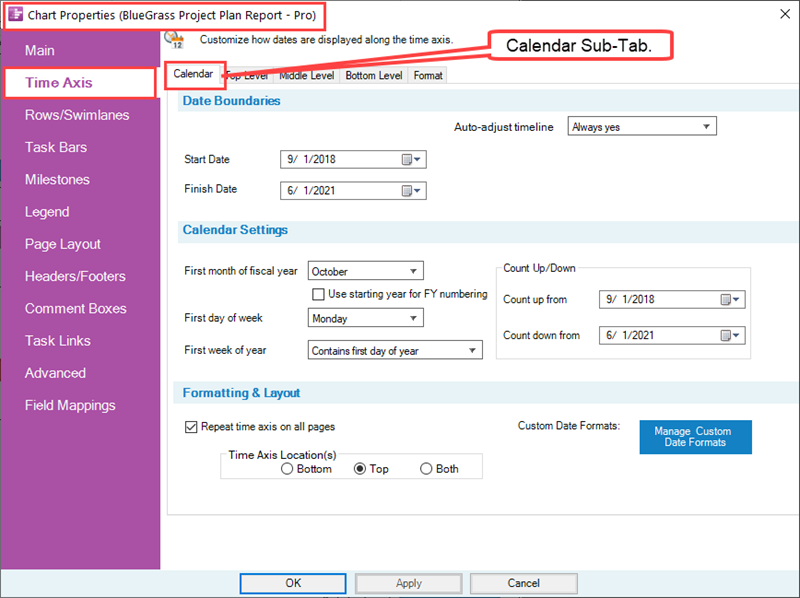
Top, Middle, and Bottom Level Sub-Tabs
The Middle Level Sub-Tab, which is typical of the three (3) such sub-tabs, looks like this:
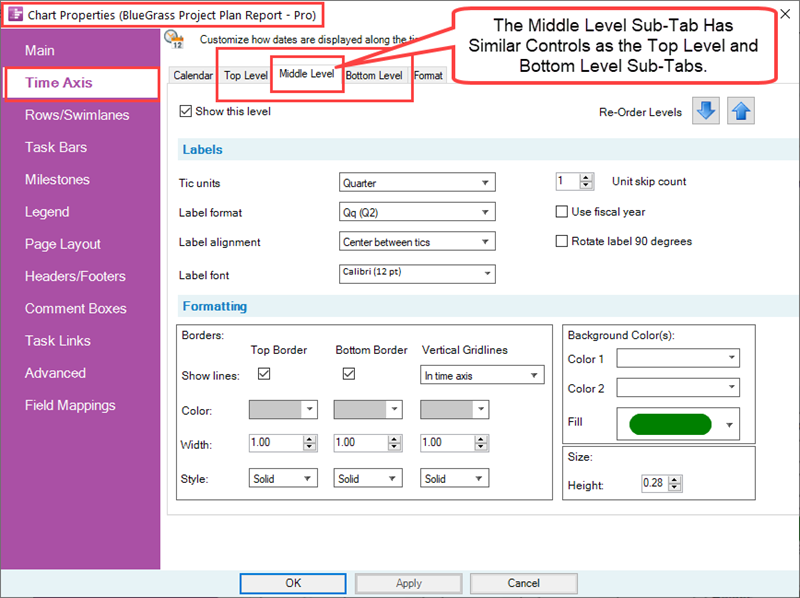
Format Sub-Tab
The Format Sub-Tab looks like this:
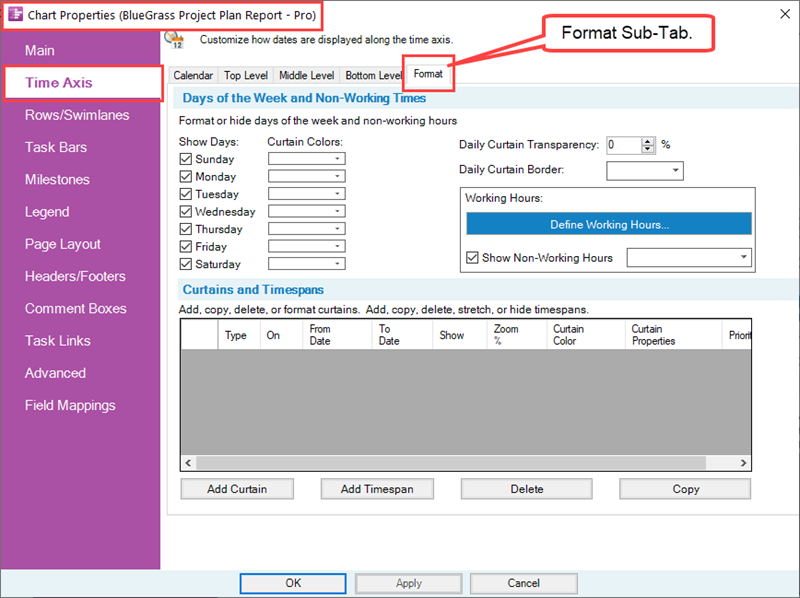
More information on editing with the Chart Properties form’s Time Axis tab and sub-tabs, please see the article at: Editing Time Axes with the Chart Properties Form for OnePager Pro
Given the controls shown above, you have significant control over the display of the Time Axis as discussed under the topics that follow.
Globally Editing Chart Time Axis Levels and Cells
Global edits are made in the Template Properties form for all charts created with that Template Properties form or with the Chart Properties form for all editable graphic elements with a particular chart covered by that Chart Properties form. The examples that follow are made with the Chart Properties form. Below is a sample chart showing some edits in the three Time Axes for level height, cell text color, background colors, and cell height:

Editing the Chart’s Start/Finish Date Boundaries
In previous OnePager versions setting the Start/Finish Date boundaries for the chart was in the Chart Properties form’s Main tab. These controls are now consolidated in the Chart Properties form’s new Time Axis tab at the Calendar sub-tab as shown here:
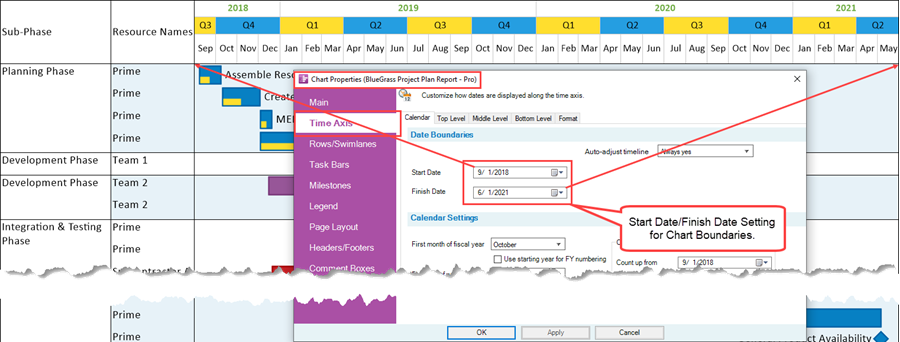
The Start Date and Finish Date boundaries can be edited by accessing the Calendar dropdown as shown below:
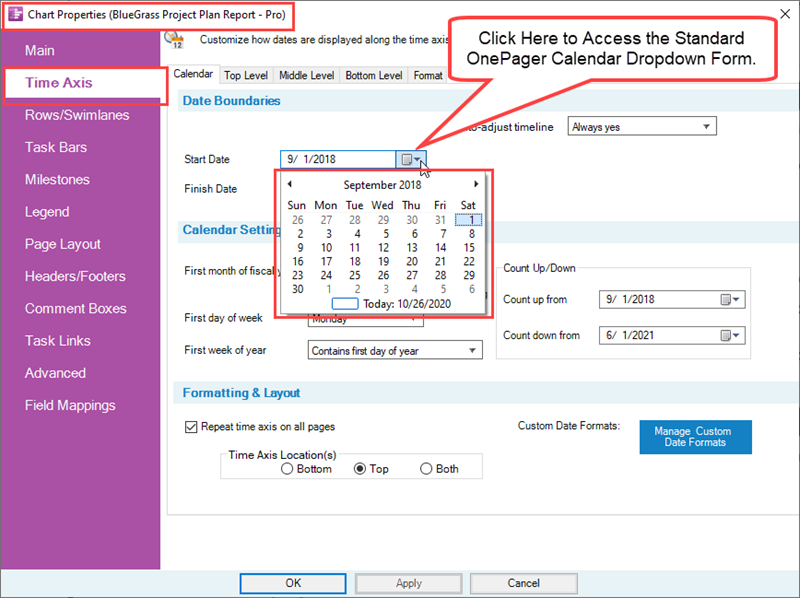
Making edits to the Start Date and/or Finish Date boundaries resets the Date Boundaries for the chart.
Another way to edit the chart’s Date Boundaries is to use the Start and Finish Date Calendars available on the OnePager Pro View ribbon tool bar tab in the Dates group as shown here:

More information on changing the Start/Finish Date boundaries, please see the article at: Changing the Chart’s Start/Finish Dates for OnePager Pro
Showing and Hiding Time Axis Levels and Cells
Time Axis Level Cells and Floating Time Axis Level Cells can be hidden to create timespan gaps in the chart's timeline.
The following example shows the creation of such a timespan gap:
- 1) Below is the original Time Axis with all Cells shown:

- 2) You can manually select the months of September through November of 2019 (with a CTL+Left-Click) and hide the cells by a right-click on a selected Cell to access the time axis right-click context menu and the Hide cell command as shown below:

- 3) Clicking the Hide cell command results in the chart looking like this:

As the illustration above shows, a three month timespan is hidden in the gap. OnePager retains a record of this in the table found in the Chart Properties form Time Axis tab Format sub-tab’s Curtains and Timespans control group as shown below:
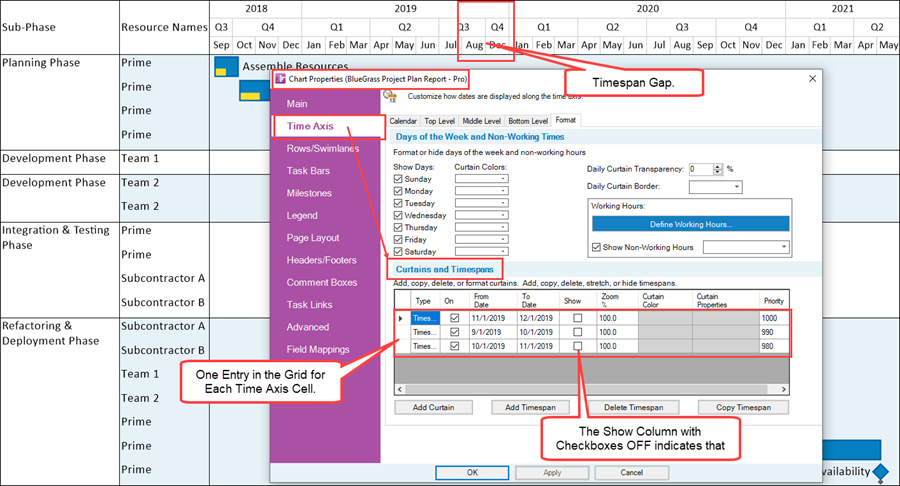
If, in the course of Hiding Time Axis Level Cells, task bars/milestone symbols become hidden, entries are made in the Where’s My Stuff!? form. Select the Quarterly Time Axis Level Cells to be hidden as shown below:
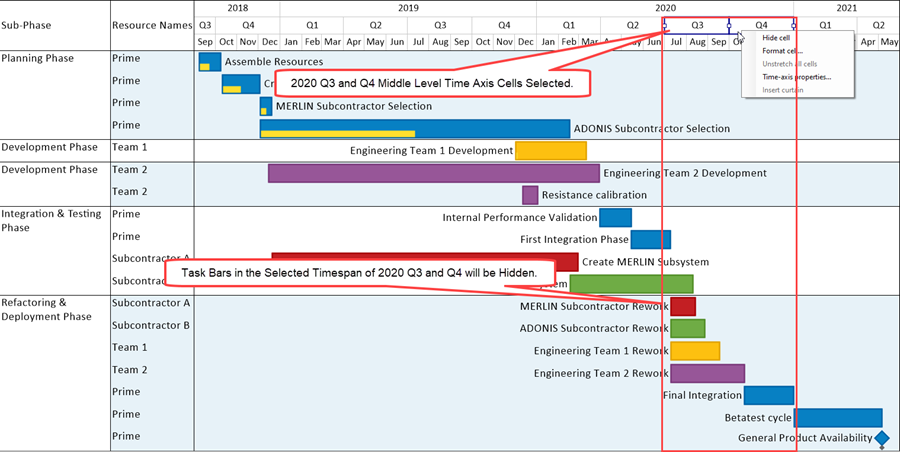
After hiding the two Quarterly Time Axis Level Cells the chart looks like this with the Where’s My Stuff!? form visible:
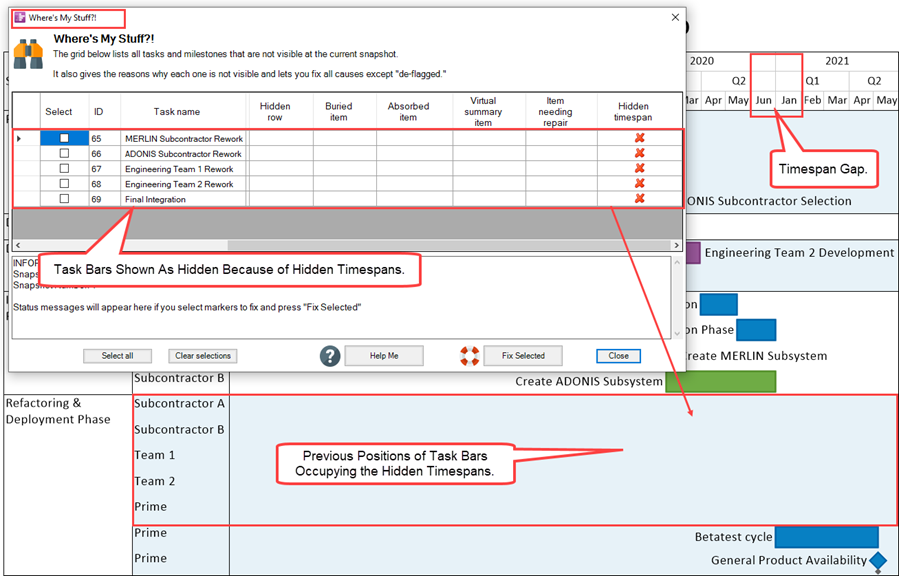
To restore the Time Axis Level Cells select the five entries by checking each checkbox in the Select column (or clicking the Select All button) in the Where’s My Stuff!? form as is shown in the example below:
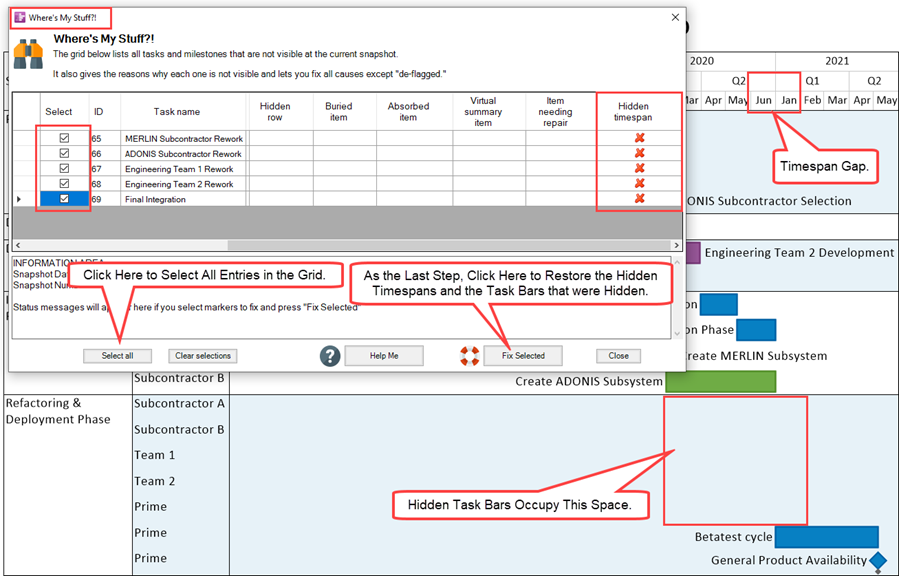
Clicking the Fix Selected button updates the Where’s My Stuff!? form to look like this:
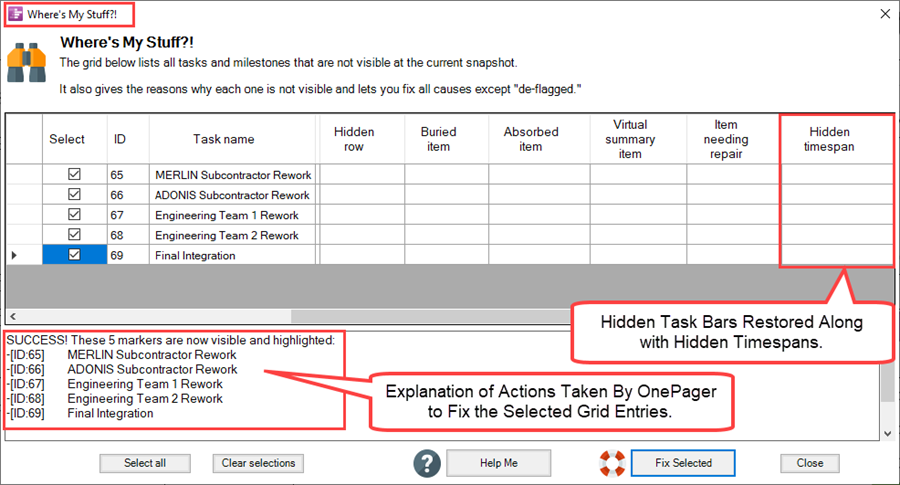
The action restores the five selected task bars to visibility along with their associated Quarterly Time Axis Level Cells as shown below:
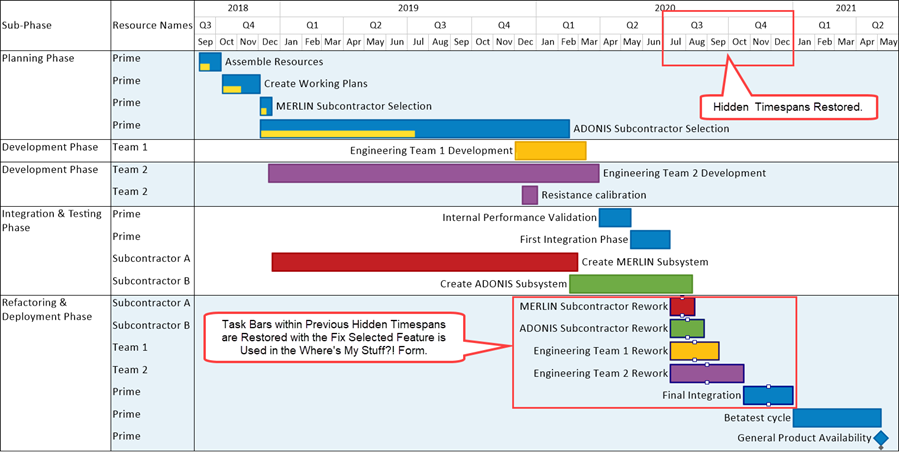
For more information on the Where’s My Stuff!? form, please see the article at: Managing Hidden Tasks and Milestones Using "Where's My Stuff?!"
Hidden Time Axis Level Cells can be restored by using the controls on the OnePager Home ribbon tool bar tab’s Show/Hide dropdown menu by clicking the Show All Time Axis Cells command as seen here:
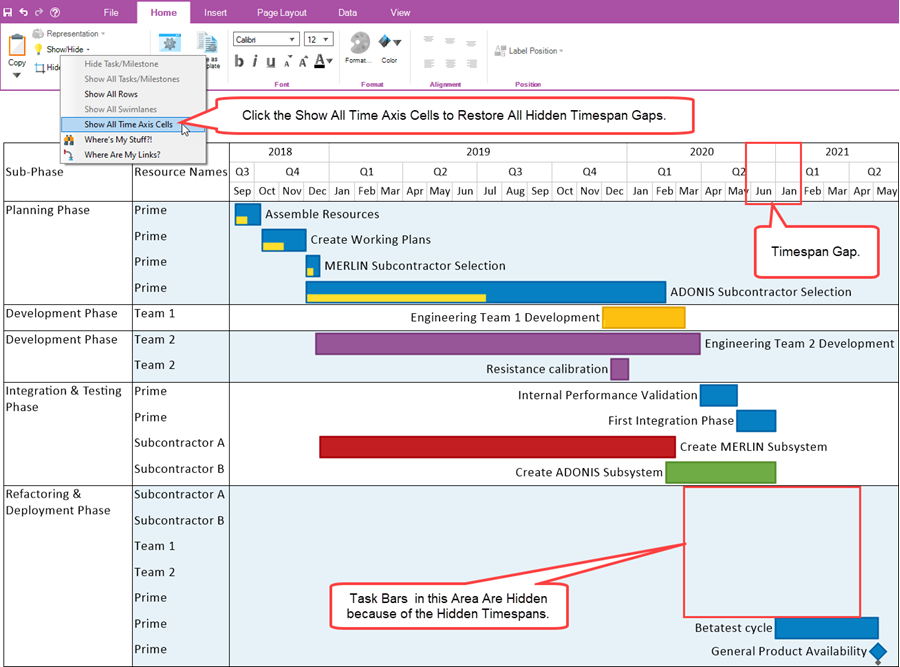
After clicking the Show All Time Axis Cells command, the five hidden month Time Axis Level Cells become unhidden. The dates used in the Curtains and Timespans Grid to define the hidden timespan include not only the date for From/To Dates but the time of day as well. If you just specify dates, OnePager assumes that the From Date starts at midnight on that day and the To Date end a minute before midnight on that day. To completely specify the timespan for a Time Axis Level Cell to be hidden it is important to make sure that the timespan is complete.
As an example, to hide the month of January 2019 the From Date should be 1/1/2019 and the To Date should be 2/1/2019 as shown here: - Replace with New Screenshot
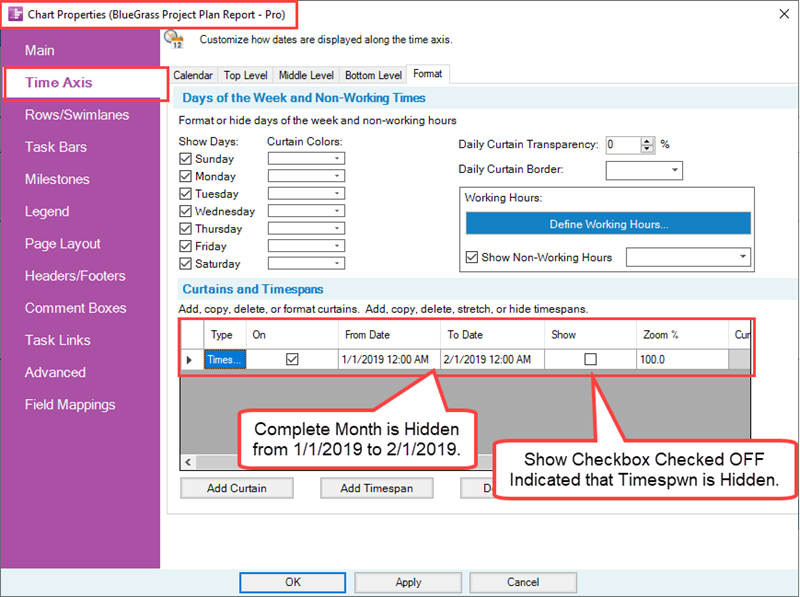
Hiding Time Axis Level Cells overrides all other settings that you specify by way of Flagging task bars for import or any specified Conditional Import rules you defined. Although the import takes place, hidden Time Axis Level Cells govern what is shown after import.
More information on hiding/showing Time Axis Cells , please see the article at: Showing and Hiding Time Axis Levels and Cells for OnePager Pro
Re-Ordering Time Axis Levels
In addition to being able to now easily hide Time Axis Levels, you can also exchange Time Axis Level positions. Given the chart below where the Top, Middle, and Bottom Time Axis Levels in Year, Quarter, and Month are ordered from top to bottom, you can exchange the Middle Level with the Top Level by clicking the up arrow in the Re-Order Levels control group:
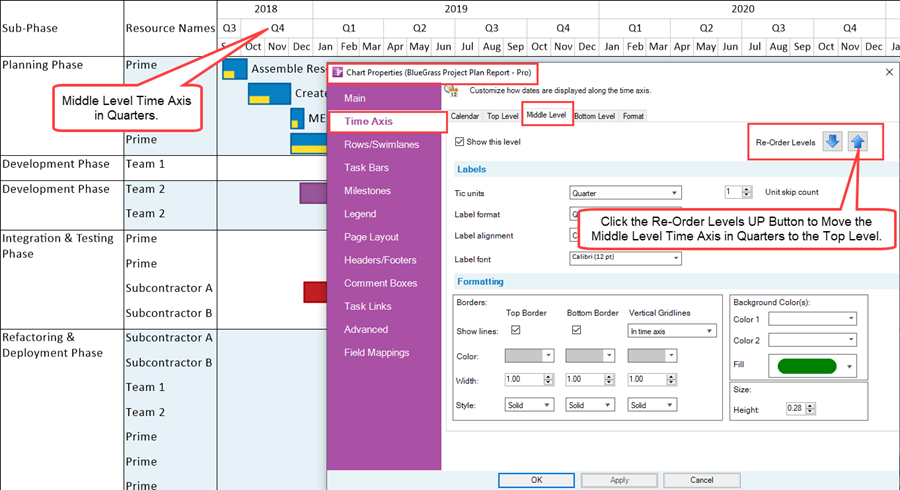
When you click the Apply or OK button in the Chart Properties form the Top and Middle Levels are exchanged as shown here:
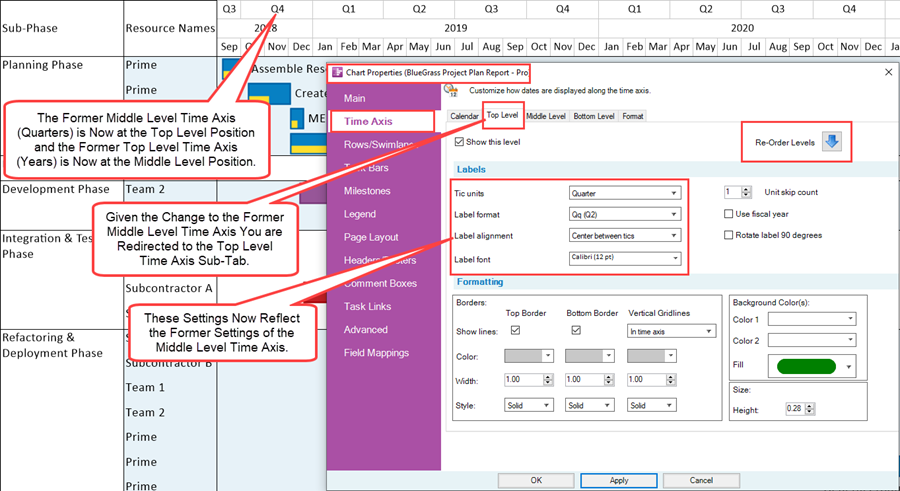
More information on Re-Ordering Time Axis Levels, please see the article at: Re-Ordering Time Axis Levels for OnePager Pro
Using the Labels Control Group on the Top, Middle, and Bottom Sub-Tabs
The controls in the Labels control group of these three sub-tabs, shown in the illustration above, provides the means for you to select the characteristics of the timespans associated with the Time Axis Level being edited.
For more information on the use of the Labels control group and its controls, please see the article at: Labeling Time Axis Levels for OnePager Pro
Using the Formatting Control Group on the Top, Middle, and Bottom Sub-Tabs
The Formatting control group on the these three sub-tabs, again, shown in the illustration above, provides the controls for managing the look of the borders associated with the three Time Axis Levels in the chart.
For more information on the use of the Formatting control group and its controls, please see the article at: Changing the Time Axis Borders for OnePager Pro
Saving Time Axis Level and Cell Settings in the Template Properties Form
OnePager Pro allows you to save the settings for a chart as a new Template Properties form with a Template Properties form name of your choosing. This can be done any time after creating or editing a chart by clicking the Save as Template button on the OnePager Pro or Express Home ribbon tool bar tab as shown below:

For more information on the Save as Template function, please see the article at: Managing the Current Template. 24.6.1-70
If your chart contains Hidden Time Axis Level Cells, these settings are copied to the new Template Properties form and saved. When the Template Properties form you previously saved is used to create a NEW chart, that chart reflects the Hidden Time Axis Level Cells you previously created. In the saved Template Properties form, the Hidden Time Axis Level Cells are represented in the Curtains and Timespans Grid as shown in the example below:
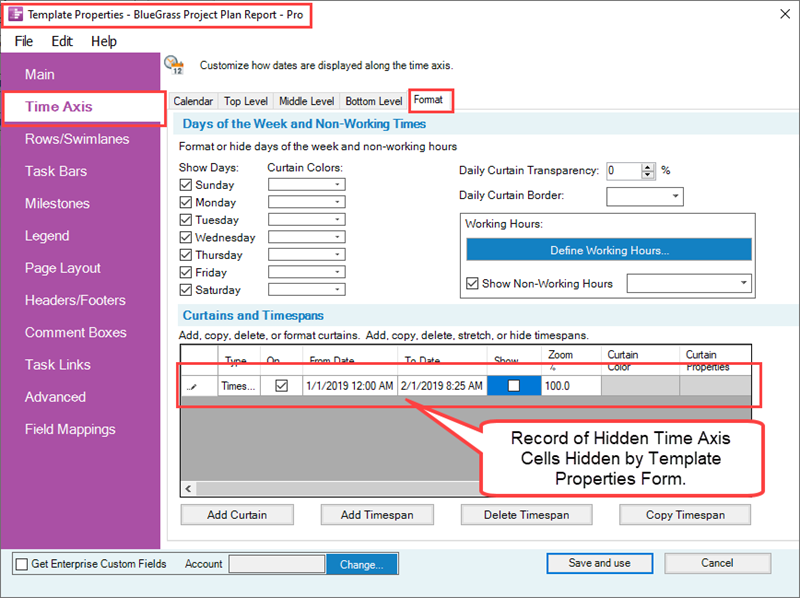
When the above Template Properties form is used again, any Time Axis Level Cells that are between the From Date and To Date are treated as Hidden Time Axis Level Cells. You can also edit the Zoom% value in a chart that is copied to become a new Template Properties form. When the saved Template is used again to create a chart, these saved Zoom% values are used on the new chart’s Time Axis Levels. Editing any of the corresponding settings in the Chart Properties form’s Time Axis tab’s Format sub-tab does not change the corresponding settings in the Template Properties form. Settings can be edited in the Template Properties form but the form must be resaved so that the edited settings are available for subsequent use the next time this Template Properties form is used to represent Hidden Time Axis Level Cells.
The Non-Linear Time Axis Feature
Below is an example of chart with a Non-Linear Time Axis representation for the bottom level Time Axis. The Non-Linear Time Axis is created as described below. First the original Bottom Level Time Axis representation with the Cell to be stretched selected with a left-click:

After stretching the January 2020 Time Axis Level Cell to the right with a drag and drop action the chart looks like this:

Note that the stretching of the bottom level Time Axis is accompanied by a stretching of the Middle Level and Top Level as shown in the example above. Additionally, any task bars/milestone symbols within the timespan stretched also appear to be stretched. In some cases the width of the chart is increased. You can select multiple Time Axis Level Cells using the CTL+Left-Click method in a single or in multiple Time Axis Levels. Selecting a single Time Axis Level Cell in any Time Axis Level allows you to further right-click on the selected Cell, access the time axis right-click context menu, and use any of the commands in the context menu as shown below:

Selecting multiple Time Axis Level Cells in any Time Axis Level and right-clicking on any selected Cells also accesses the time axis right-click context menu where most of the context menu’s command can be used. Selecting multiple Time Axis Level Cells in different Time Axis Levels with the intent of stretching all the selected Cells is not supported. If this is attempted, OnePager Pro only stretches those selected Time Axis Level Cells in the Time Axis Level where you used the mouse to stretch one of the selected Cells. Time Axis Level Cells in other Time Axis Levels are de-selected before the stretch drag and drop operation is started.
More information on the new Non-Linear Time Axis feature, please see the article at: The Non-Linear Time Axis Feature for OnePager Pro
The Floating Time Axis Feature
Below, highlighted in green, is an example of an inserted Floating Time Axis:

Inserting a Floating Time Axis is done by right-clicking in the Row of the graph area to access the open space right-click context menu where you want the Floating Time Axis Level to appear either ABOVE or BELOW as shown here:
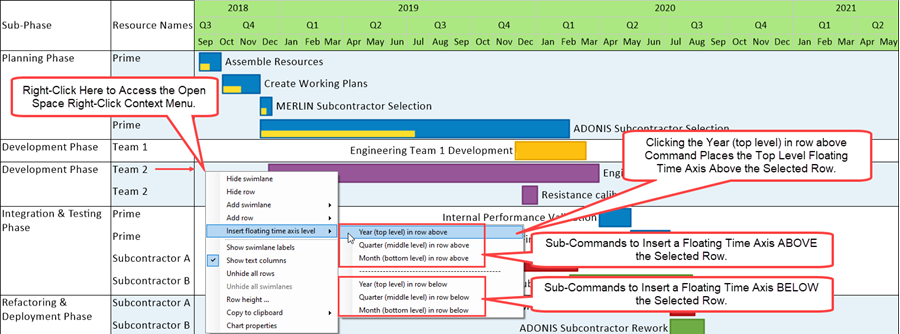
If you select the Insert floating time axis level sub-command to place the Top Level Time Axis ABOVE the selected row, the chart looks like this:
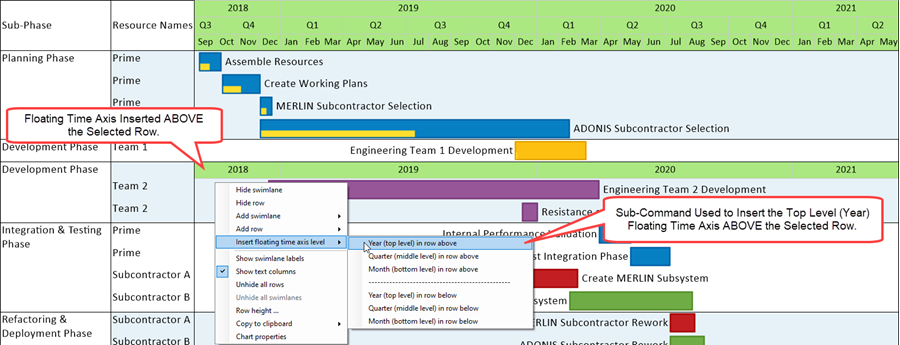
Repeating the process for Inserting the Middle Level Floating Time Axis ABOVE the selected Row creates two levels shown below:
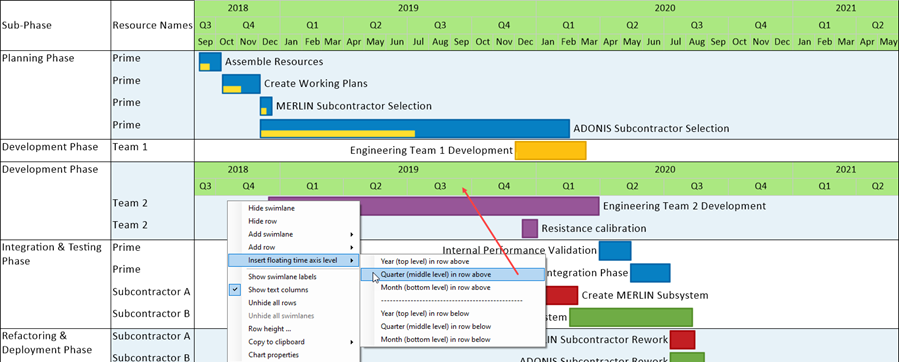
When the action above is completed, all three levels of the Floating Time Axis appear:
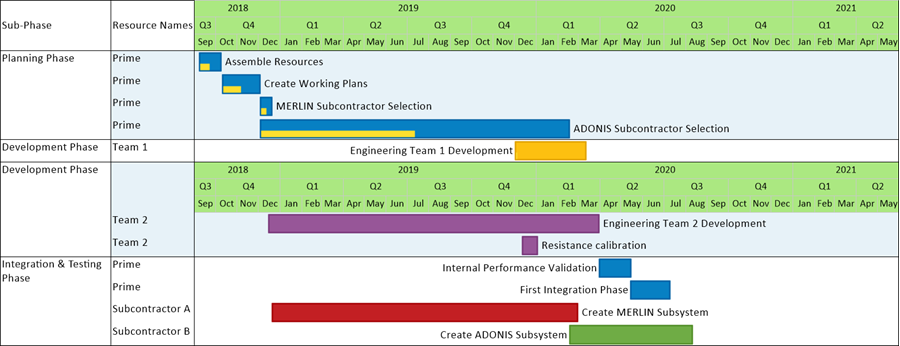
The same procedure can be used to Insert Floating Time Axis Levels BELOW the selected Row by accessing the open space right-click context menu in the desired Row in the graph area and using the alternate set of sub-commands that place Floating Time Axis Levels BELOW the selected Row.
Several individual or sets of Floating Time Axis Levels can be inserted in a chart. If you are not sure which Time Axis Level was inserted as a Floating Time Axis, you can always do the following to double-check. Right-click on any Time Axis Level Cell in the Floating Time Axis in question which accesses the time axis right-click context menu. Then click the Chart properties command as shown in the above illustration. When you do this, the Chart Properties form Time Axis tab appears at the Time Axis Level sub-tab belonging to the Floating Time Axis Level you originally right-clicked.
Any manual edit made to a Time Axis Level Cell is reflected in the corresponding Floating Time Axis Level Cell with respect to the Cell properties that can be edited using the Chart Properties form Time Axis tab’s three Level sub-tab property setting controls and using the time axis right-click context menu’s Format cell… command. Manual edits made to a Time Axis Level such as editing its height in the Chart Properties form Time Axis Level tabs are NOT made to the corresponding Floating Time Axis Level. Performing edits on the Row in which a Floating Time Axis Level resides either by using the Row right-click context menu commands or the Edit Row properties form does NOT make corresponding edits to the properties of the corresponding Time Axis Level. Only edits to individual or multiple Time Axis Level Cells are mirrored in their corresponding Floating Time Axis Level Cells and vice versa.
More information on the new Floating Time Axis feature, please see the article at: The Floating Time Axis Feature for OnePager Pro
Enhanced Manual Editing of Timespans (Time Axis Level Cells)
By right-clicking on a Time Axis Level Cell it can be edited by using the commands in the time axis right-click context menu as shown here:

Right-click in the text label column of a Floating Time Axis Level to edit the Floating Time Axis Level using the commands in the row right-click context menu as shown below:

Right-clicking in a Floating Time Axis Level Cell selects the Cell and accesses the floating time axis right-click context menu to edit the Cell as shown below:

More information on manual editing of Timespans, please see the article at: Manual Editing the Time Axis for OnePager Pro. 22.4.3-70
Other Time Axis Related Capabilities Provide in OnePager Pro
In addition to the features and capabilities discussed above, OnePager Pro includes additional time axis level and cell capabilities:
- 1) The Custom Date Format Feature
- 2) Managing Working Hours and Non-Working Hours
- 3) Managing Manually Inserted Curtains
- 4) Creating and Editing Daily Curtains
- 5) Managing Timespans in the chart
The topics above are advanced capabilities of OnePager.
More information on these topics can be found at the table of links below:
Related Links
Modifying the Time Axis (Portal)
Labeling Time Axis Levels for OnePager Pro
Changing the Time Axis Borders for OnePager Pro
The Floating Time Axis Feature for OnePager Pro
Editing Time Axes with the Chart Properties Form for OnePager Pro
Changing the Chart’s Start/Finish Dates for OnePager Pro
Managing Hidden Tasks and Milestones Using "Where's My Stuff?!"
Showing and Hiding Time Axis Levels and Cells for OnePager Pro
Switching Time Axis Levels for OnePager Pro
The Non-Linear Time Axis Feature for OnePager Pro
Manual Editing the Time Axis for OnePager Pro
The Custom Date Format Feature for OnePager Pro
Managing Working Hours and Non-Working Hours for OnePager Pro
Creating, Editing, and Managing Time Axis Daily Curtains for OnePager Pro
(22.1.1-70)